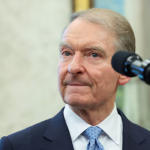The One Story to Read Today newsletter included this article. Register here.
Twitter existed prior to DOGE. Elon Musk appeared too preoccupied with his most recent project in 2023 to manage the most valuable automaker in the world. As he concentrated on revamping (and rebranding) the social media platform, Tesla was struggling. Musk responded with a rare display of force at Tesla’s investor-day event in Austin that March. To show that even though he was very busy, Tesla was managed by a top-tier team, he was joined onstage by a group of over a dozen of the company’s top executives: “We’ve obviously got significant bench strength here,” Musk said. As expected, Tesla had its highest-ever sales at the end of 2023.
As he returns from Washington to concentrate on his faltering auto company, Musk is in dire need of a similar comeback. Sales of Tesla have fallen precipitously in recent months as the far-right, chainsaw-wielding centibillionaire has alienated traditionally liberal buyers of electric vehicles. Since the Trump-Musk feud is over, the MAGA faithful are less likely to step up and take their place, which they never did. Musk has other issues: Tesla invented the modern electric vehicle, but the company is now lagging behind its rivals, and Musk is more interested in robots and artificial intelligence than in making cars. In addition to all of that, Tesla might lose billions of dollars annually if the One Big Beautiful Bill Act passes Congress.
But even if Musk wanted to, he couldn’t rely on that bench mentioned earlier this time. Tesla has been experiencing a situation akin to DOGE’s severe staffing reductions. Approximately one-third of the executives who joined him onstage two years ago have either departed from Tesla or been fired. Numerous other well-known business executives have quit. The heads of software engineering, battery technology, and humanoid robotics at Tesla have all left the company since April. Waves of mass layoffs last year resulted in the departure of tens of thousands of rank-and-file workers. Tesla is ultimately the Musk show; it is the primary source of his wealth and the foundation of his image as a technological genius. After all of the changes and losses, Musk now has more control over Tesla’s future than ever before.
Longtime Tesla observers like myself were accustomed to the tumultuous, fast-paced cuts that characterized Musk’s time at DOGE. At Tesla, the playbook was invented. Tesla was a start-up that was having trouble producing its first automobile when Musk became CEO in 2008. Many people attribute the automaker’s success to his early personal funding infusions, brutal cost-cutting methods, and, as he put it, “hardcore” work environment. He has a well-known method for solving any kind of issue: Get rid of all preconceptions, demolish everything, and start over. It’s okay if things break. Most likely, they can be fixed in the future. The traditional turn-signal switch was once removed from some cars by the company and then reinstalled. (My requests for comment from Tesla and Musk were not answered.)
The tactic worked for a while. Despite selling a small percentage of the vehicles its competitors sold, Tesla went from a start-up to an auto giant worth more than Ford, Toyota, and GM combined in just ten years. For this reason, investors continue to support Musk today. He’s the man to solve problems if they arise because he’s made them a lot of money in the past, right? The notion that Musk knows everything has been spread by Musk himself. He once declared that, as part of a “hardcore” round of cost-cutting, he would personally begin authorizing some of his employees’ expenses. Sam Abuelsamid, an auto-industry analyst at the research firm Telemetry, told me, “He has always been the type of person who says, ‘I am the only one who can do this.'” When I was editor-in-chief of the car magazine Jalopnik in 2018, the now-defunct communications team at Tesla angrily chastised us for publishing information about the departure of the company’s chief engineer, Doug Field. According to a spokesperson, he was only the best vehicle engineer. Musk was the top engineer even though he had no engineering training.
According to a 2019 analysis by the financial firm Bernstein, Tesla’s executive turnover rate was “dramatically higher” among Musk’s direct reports and nearly twice as high as the average for similar Silicon Valley companies. Firings and layoffs have occasionally felt more erratic than anything else. Think about the group that created the network of Tesla charging stations. I wrote in June 2023 that Tesla’s secret weapon was its dependable and quick “Superchargers.” Other automakers had started incorporating Tesla’s proprietary charging port into their vehicles so that their customers could access Superchargers. A year or so later, Tesla let go of all 500 employees. Rebecca Tinucci, Tesla’s head of charging, left permanently, but many of the employees were later rehired and returned. Since then, the Supercharger network has expanded, albeit not without a period of turmoil for the automaker and the entire auto industry that placed bets on it.
Last year, a larger headcount reduction included the layoffs of Tesla’s charging staff: According to internal data seen by CNBC, Tesla laid off almost 20,000 workers in the first half of 2024. Additionally, Tesla boasted of “a $52 million decrease in employee and labor costs” over the previous year in its most recent quarterly SEC filing, which was made public in April. (I contacted about a dozen current and former Tesla employees in order to report this story. None of them would speak to me in public.)
Musk claimed that the purpose of last year’s layoffs was to prepare the business for its “next phase of growth.” That implies AI based on what he has said thus far. He has stated that “a trillion dollars of profit a year” will eventually be generated by robots and autonomous vehicles. Following their alleged disagreements with Musk regarding his pivot, a number of senior executives and engineers have resigned. With what Musk has stated will be “10 to 12” self-driving Teslas that can also be remotely operated by humans if necessary, Tesla is reportedly planning to begin its eagerly anticipated robotaxi service in Austin this month. To put it another way, the business is still a long way from becoming anything like an autonomous Uber. As of right now, Tesla still generates its revenue from the sale of automobiles, and it has lost many of the bright individuals who contributed to the development of the once-innovative automotive giant.
Tom Zhu, a senior vice president who oversaw Tesla’s operations in China, and Lars Moravy, who is in charge of vehicle engineering, are two of Musk’s longstanding deputies. However, Musk is under more pressure as a result of the departures because he no longer has the workforce he once had to develop innovative electric cars.
The fact that these former Tesla employees are spreading to other automakers is a good sign for the future of electric vehicles. Consider Field, the former chief engineer for Tesla (or, as Tesla puts it, “head vehicle engineer”). At Ford, he currently oversees a program tasked with creating an affordable EV in addition to advanced vehicle software. Tinucci, who previously led Tesla’s charging staff, is currently in charge of Uber’s transition to electric cars. The founder of Nia Impact Capital, an investment firm that owns stock in Tesla, Kristin Hull, told me, “I think we’ll see kind of a Tesla diaspora.” “The rest of the world is catching up.” And I believe that’s contributing to the talent’s departure as well. (Requests for comment from Field and Tinucci were not answered.)
Musk’s critics could easily succumb to schadenfreude. It’s possible that his actions are finally getting to him. However, the consequences of Tesla’s decline will go beyond Musk and his investors just losing money. Tesla is uniquely positioned to produce an extremely affordable electric vehicle because it is still one of the few businesses outside of China that is profitable from the sale of electric vehicles. Every day that passes without more affordable alternatives, Americans who might otherwise be considering switching to electric vehicles instead purchase gas-powered vehicles that may last for ten or more years. To keep up with Tesla, other automakers have been rushing to produce cleaner vehicles for years. It’s easy to see a highly polluting industry revert to its old practices if the company’s dominance is lost. Given the Trump administration’s heavy reliance on fossil fuels, the risk is especially high at the moment.
Not Musk’s fortune, but other people’s trust in him, will be put to the test if Tesla can recover. Many still fervently believe that Musk can make them wealthy, despite the fact that he has already alienated both left and right-wingers. Even they may eventually begin to disappear.













